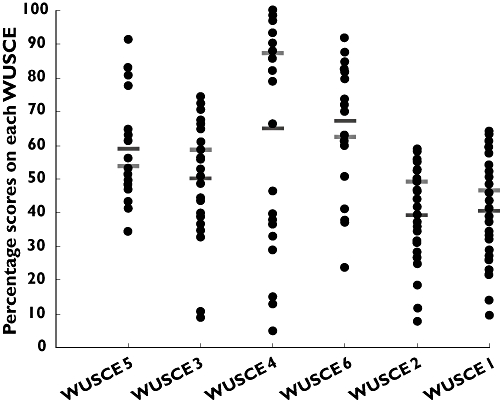Figure 2.

The spread of percentage scores obtained by individual FY1 doctors across each WUSCE. The possible scores in each WUSCE vary and are given in the key (below). The figure also shows the relationship of the mean percentage average scores obtained and the pass percentage for each WUSCE. Confidence intervals are not shown in this figure. Key:  = Pass mark of assessment item
= Pass mark of assessment item
 = Mean average mark obtained by FY1 on each assessment item WUSCE 5 topic = Contra-indications in the use of anti-coagulates and antibiotics WUSCE 3 topic = Anti-coagulants and analgesics in the post-operative patient WUSCE 4 topic = Diverticular disease; i.v. administration of antibiotics WUSCE 6 topic = Respiratory; Chronic obstructive pulmonary disease WUSCE 2 topic = Analgesia in emergency medicine WUSCE 1 topic = Renal failure; fluid management and artiopathy Number of FY1 doctors completing the assessment item = WUSCE 1 = 44, WUSCE 2 = 33, WUSCE 3 = 25, WUSCE 4 = 21, WUSCE 5 = 20, WUSCE 6 = 18. Maximum possible scores for each question are: WUSCE 1 = 69.8, WUSCE 2 = 43, WUSCE 3 = 44.5, WUSCE 4 = 14.9, WUSCE 5 = 46.5, WUSCE 6 = 21.6. Minimum possible scores for each question are: WUSCE 1 =−13, WUSCE 2 = 0, WUSCE 3 = 0, WUSCE 4 = 0, WUSCE 5 =−2, WUSCE 6 =−4. Range of scores on each question (max;min): WUSCE 1 = 6.0 to 45.5, WUSCE 2 = 3.3 to 25.5, WUSCE 3 = 4.0 to 33.1, WUSCE 4 = 0.8 to 14.9, WUSCE 5 = 16.0 to 42.5, WUSCE 6 = 5.2 to 19.8
= Mean average mark obtained by FY1 on each assessment item WUSCE 5 topic = Contra-indications in the use of anti-coagulates and antibiotics WUSCE 3 topic = Anti-coagulants and analgesics in the post-operative patient WUSCE 4 topic = Diverticular disease; i.v. administration of antibiotics WUSCE 6 topic = Respiratory; Chronic obstructive pulmonary disease WUSCE 2 topic = Analgesia in emergency medicine WUSCE 1 topic = Renal failure; fluid management and artiopathy Number of FY1 doctors completing the assessment item = WUSCE 1 = 44, WUSCE 2 = 33, WUSCE 3 = 25, WUSCE 4 = 21, WUSCE 5 = 20, WUSCE 6 = 18. Maximum possible scores for each question are: WUSCE 1 = 69.8, WUSCE 2 = 43, WUSCE 3 = 44.5, WUSCE 4 = 14.9, WUSCE 5 = 46.5, WUSCE 6 = 21.6. Minimum possible scores for each question are: WUSCE 1 =−13, WUSCE 2 = 0, WUSCE 3 = 0, WUSCE 4 = 0, WUSCE 5 =−2, WUSCE 6 =−4. Range of scores on each question (max;min): WUSCE 1 = 6.0 to 45.5, WUSCE 2 = 3.3 to 25.5, WUSCE 3 = 4.0 to 33.1, WUSCE 4 = 0.8 to 14.9, WUSCE 5 = 16.0 to 42.5, WUSCE 6 = 5.2 to 19.8
